Exploring the Unique Traits of the American Robin
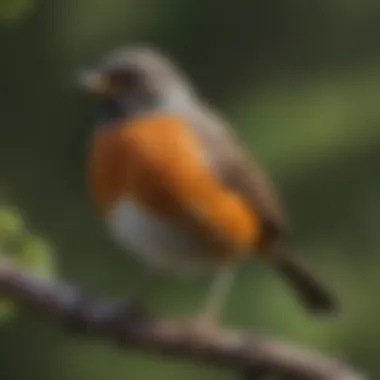
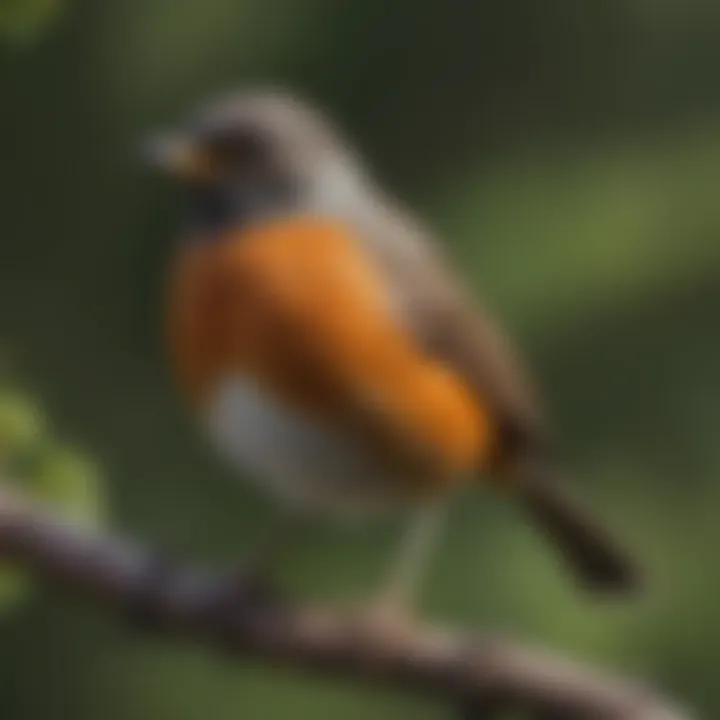
Nature Topic Overview
Fun Facts and Trivia
Did you know that the American Robin is not just a pretty face? Here are some fun tidbits that might surprise you:
- Singing Sensation: Robins are one of the first birds to sing in the early morning. Their song is often seen as nature's alarm clock.
- Versatile Diet: While they enjoy berries and fruits, robins primarily feast on insects, especially during the spring and summer months. They can eat worms, beetles, and caterpillars.
- Unique Nesting: Robins build their nests usually in trees, but sometimes they opt for shrubs or even man-made structures like hanging planters.
Visual Learning
To engage young readers visually, consider providing a colorful infographic of the American Robin's lifecycle or a picture gallery showcasing their different plumage throughout the seasons.
Wildlife Explorations
The American Robin is part of a larger avian family that includes many other interesting species. Here are some notable relatives:
- Eastern Bluebird: Known for its bright blue feathers, the Eastern Bluebird shares similar habitats with robins but has a different diet, focusing more on insects.
- Varied Thrush: This bird resembles the robin but is found in the western parts of North America. Its calls are quite distinct from the robin’s cheerful tunes.
Additionally, the American Robin plays a significant role in its ecosystem, serving as both a predator and prey. It helps control insect populations while also being a food source for larger birds of prey.
Interactive Challenge
To make learning fun, create a quiz titled "Can You Spot the Differences?" featuring images of the American Robin and its relatives, challenging children to identify unique characteristics.
Environmental Awareness
Understanding the role of the American Robin in nature encourages a sense of responsibility among young readers about conservation. As urbanization expands, robins often face habitat loss. Here’s how children can help:
- Plant Native Plants: Encourage planting fruit-bearing plants and trees in gardens to provide food for robins.
- Clean Up Trash: Regular clean-ups in local parks and nature areas can help maintain a safe and clean habitat for robins and other wildlife.
- Build Birdhouses: Constructing simple birdhouses can provide shelter for robins and encourage them to thrive in urban areas.
Protecting robins means protecting our connection to nature. Every small action counts.
DIY Nature Activities
Here are a few engaging activities that kids can try to learn more about robins:
- Robin Feeder Craft: Use pine cones, peanut butter, and birdseed to create a simple feeder. Hang it outside and watch the robins come in!
- Bird Watching Journal: Encourage kids to keep a journal of their bird sightings. They can sketch robins they see and describe the environments they inhabit.
- Outdoor Exploration: Organize a nature walk to find and observe robins in their natural habitats. Kids can learn firsthand about where they live and what they eat.
- Gather a pine cone, peanut butter, birdseed, and string.
- Spread peanut butter over the pine cone using a knife or stick.
- Roll it in birdseed until well-coated.
- Tie a string to the top and hang it in a tree.
Preamble to the American Robin
The American Robin is more than just a bird to spot in the backyard. It plays a vital role in North American ecosystems and culture. Understanding the characteristics of this common avian resident can spark curiosity and promote environmental awareness in young readers, which is essential for future generations. This article aims to provide a comprehensive overview of the American Robin, highlighting not only its physical and behavioral traits but also its significance in various habitats and cultural contexts.
Among feathered friends, the American Robin stands out. It’s lively, sings cheerily in springtime, and heralds the arrival of warmer months to many people. For kids and adults alike, spotting one on a sunny afternoon or hearing its melodious tune can signal the change of seasons. However, its importance extends far beyond mere aesthetics. The robin is an integral part of local ecosystems, aiding in seed dispersal and pest control.
Moreover, learning about the American Robin helps foster a love for wildlife and the environment. Parents, teachers, and caregivers can use this knowledge to teach children respect for nature, making the robin a wonderful gateway to broader discussions about birds and conservation. So, let’s dive into the world of this beloved species!
Overview of the Species
The American Robin (Turdus migratorius) is a familiar sight, often associated with warm spring days. With its rounded body and orange-red breast, it’s easy to see why this bird is a favorite among many. But what makes this species particularly noteworthy is its adaptability. Hunting for worms in the morning dew or hopping along sidewalks, robins are omnipresent in urban parks and backyard gardens across North America.
This species inhabits a variety of environments, from city landscapes to lush forests. It rarely ventures far from areas where vegetation flourishes, which can provide cover and food. Interestingly, robins are migratory birds, making long journeys between breeding and wintering grounds. Many of them travel thousands of miles, showcasing their resilience and the instinct to adapt to changing seasons.
Surveying this fascinating bird reveals much about the broader topic of avian species and their roles in our ecosystem. Observing robins can also lead to questions about migration, behavior, and the relationship between wildlife and human communities.
In wrapping up this section, it becomes clear that the American Robin is more than just another bird. It embodies the natural beauty and dynamic ecosystems present in various environments around us, offering an inviting subject for exploration that engages the minds of children and adults alike.
Physical Characteristics
Size and Shape
The American Robin is medium-sized, often measuring about 9 to 11 inches in length. With a wingspan ranging from 12 to 16 inches, its body is generally plump with a rounded shape. The robins stand erect, allowing them to scan the ground as they hunt for food. Their size makes them easily recognizable and allows them to navigate various environments efficiently. Being larger than many songbirds aids them in evading predators and asserting their dominance within their habitats.
Coloration and Patterns
Body Color
The distinctive body color of the American Robin is one of its most striking features. The adult robs typically exhibit a vibrant orange to red breast, while the belly is lighter, often tinged with shades of gray. This bold coloration serves a dual purpose: it not only aids in attracting mates but also makes them stand out amid green grass or foliage, showcasing their beautifull plumage. A key characteristic of their coloration is its seasonal variation; during the warmer months, their colors might become more vivid due to the abundance of food and favorable weather. However, during colder months, the colors may appear duller, which is a clever form of camouflage against winter backdrops.
Wing Patterns
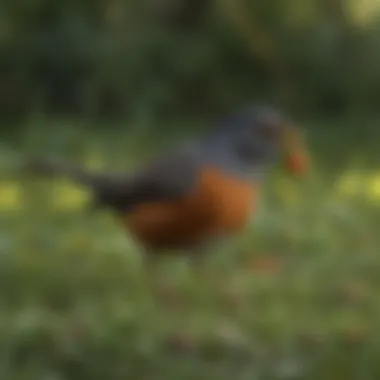
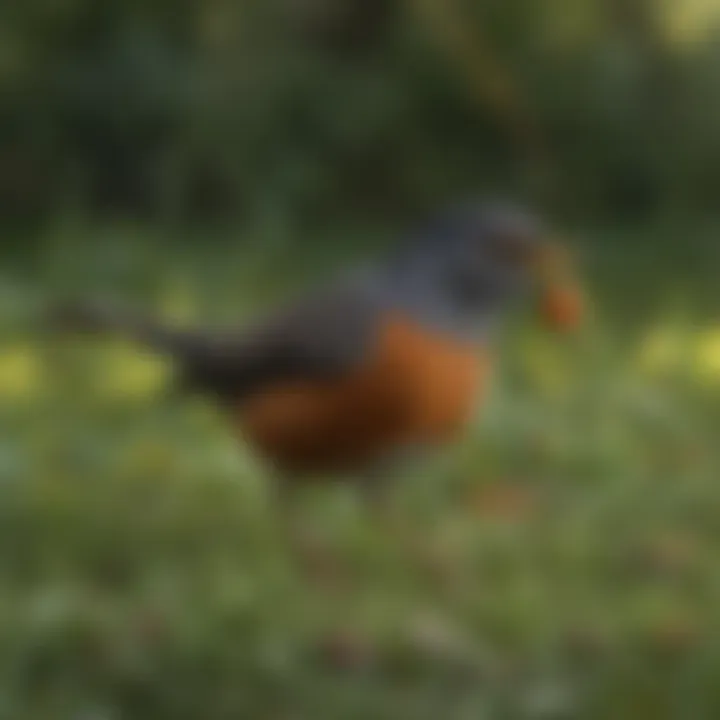
The wing patterns on the American Robin are equally fascinating. When in flight, observers can spot the white patches on their wings, which contrast sharply with the darker outer wing feathers. This distinctive pattern is not just for aesthetics; it plays a practical role in communication and mating displays. The wing patterns can signal their health and vitality to potential partners. Considering their role in flight, having well-defined patterns might help them during navigation and in showcasing their agility and speed while gliding through trees and open spaces.
Eye Color
Eye color may not seem significant, but it adds to the robin's charm. Typically, their eyes appear dark brown, which allows for an expressive demeanor when watching for predators or spotting prey. The bright eyes not only enhance their vision but also contribute to their overall striking appearance. In juvenile robins, eye color may differ slightly, as their features continue to develop as they mature. This aspect can educate young readers about the differences between adult and juvenile birds, adding depth to their understanding of bird life cycles.
Distinctive Features
Beak Structure
The beak of the American Robin is another remarkable characteristic; it's slender and pointed, well-adapted for probing the ground for insects and worms. The beak's shape enables them to extract food from the soil or catch small insects effectively. A robust and flexible structure ensures they can handle varying prey, from fruits to larger insects. This feature makes the robin an opportunistic feeder, a great quality for thriving in diverse habitats.
Tail Length
Robins have a moderately long tail that aids in balance and stabilization during flight. The tail length also contributes to their ability to make sharp maneuvers, which is essential when feeding or escaping danger. During courtship displays, their tails may be fanned out, emphasizing their vibrant plumage. The visible tail pattern both attracts mates and signals readiness for breeding, providing a competitive edge in securing partners. This aspect of their behavior is vital to understanding their reproductive strategies.
Behavioral Traits
Understanding the behavioral traits of the American Robin is key to appreciating its life and role in the ecosystem. These traits not only help the robin survive but also allow it to thrive in varying environments. They offer insights into social structures, feeding habits, and communication—all vital for young readers to learn about nature's way of balancing. By exploring these areas, we can discover how American Robins are not just common birds in our backyards but also dynamic participants in their habitats.
Feeding Habits
Diet Composition
The diet of the American Robin is really interesting because it changes with the seasons. In spring and summer, these birds enjoy a buffet of soft fruits such as strawberries and blueberries, supplemented with insects like worms and caterpillars. This mix serves as a nutritious feast, providing energy for their activities. On the other hand, during fall, robins often feast on berries from various trees and bushes.
One key characteristic of this diet composition is how adaptable it is. Whether they are in the thick woods or an urban setting, robins find what they need to munch on. However, a downside can be that not all areas have the same food availability, which might lead some robins to struggle.
Foraging Techniques
When it comes to finding their food, robins employ different foraging techniques. They might hop around on the ground, using their keen eyesight to spot worms or beetles just below the dirt. Alternatively, they may perch on a branch before swooping down to snatch up berries from bushes. This ability to vary their foraging styles is something special.
The unique feature of their techniques is how they combine sight and sound. Robins listen for movements in the grass and look carefully for colors that signal ripe fruits. This flexibility in foraging is an advantage because it allows them to adapt to different environments and changes in food supply.
Social Interactions
Territorial Behavior
Territorial behavior in American Robins is mainly seen during the breeding season. Males defend their patches fiercely, singing loudly from high branches to announce their presence. Each male stakes out a territory that ensures access to food and nesting sites, which is essential for attracting females.
What stands out about their territorial behavior is its protective nature. By marking their ground, male robins keep competitors at bay, ensuring that they have the best chance to mate and raise their young. However, this behavior can lead to conflicts with other robins, sometimes causing injuries.
Flock Dynamics
Outside of the breeding season, robins become more social and often gather in flocks. This change in behavior highlights an important aspect of their social dynamics. In flocks, robins can share information about food sources and alert each other to danger. They thrive on community when conditions require coming together for survival.
The unique aspect of flock dynamics is that it emphasizes cooperation. By working as a group, robins can look out for each other, which offers mutual benefits during migration or harsh weather. Yet, this sociality can lead to competition for the same food sources, creating a balance between camaraderie and rivalry.
Communication Methods
Vocalizations
American Robins are known for their beautiful songs. Their vocalizations are not just pleasant sounds; they serve practical purposes too. Songs help males establish their territories and attract mates, while alarm calls alert other birds of potential threats. On the whole, their vocal repertoire is quite varied, with soft trills and sharp warning cries.
The most prominent feature of their vocalizations is how easily they adapt to different settings. While in the woods, a robin’s song may be more subdued, but in gardens, it can be vibrant and boisterous. This adaptability is crucial as it maximizes communication effectiveness.
Body Language
Body language plays an equally vital role in how robins interact. From puffing up feathers to signal aggression to bowing low to display submission, their posture communicates moods and intentions. By observing these behaviors, younger audiences can learn how body language complements sounds in animal communication.
A key characteristic of their body language is its subtlety. For instance, a robin's tilt of its head can indicate curiosity, while a still stance may suggest caution. In quiter moments, these expressions add layers to their social interactions and highlight the richness of their communications.
Understanding these behavioral traits can illuminate not just the life of the American Robin, but also the interconnectedness of species in our environment.
To conclude, studying the behavior of the American Robin presents a tapestry of interactions and adaptations. These traits showcase how robins manage to live and interact with their surroundings, contributing to their survival and the ecosystem's balance.
Habitat Preferences
Understanding the habitat preferences of the American Robin is key to appreciating this delightful bird. Robins are adaptable creatures, choosing environments that support their survival and breeding habits. By diving into their preferred settings, one can see how these choices affect their lifestyle, interactions, and overall health.
Preferred Environments
When it comes to their living quarters, American Robins don’t skimp on options. They thrive in various environments, each bringing its unique benefits and challenges. Let’s dig into the three primary environments they can call home.

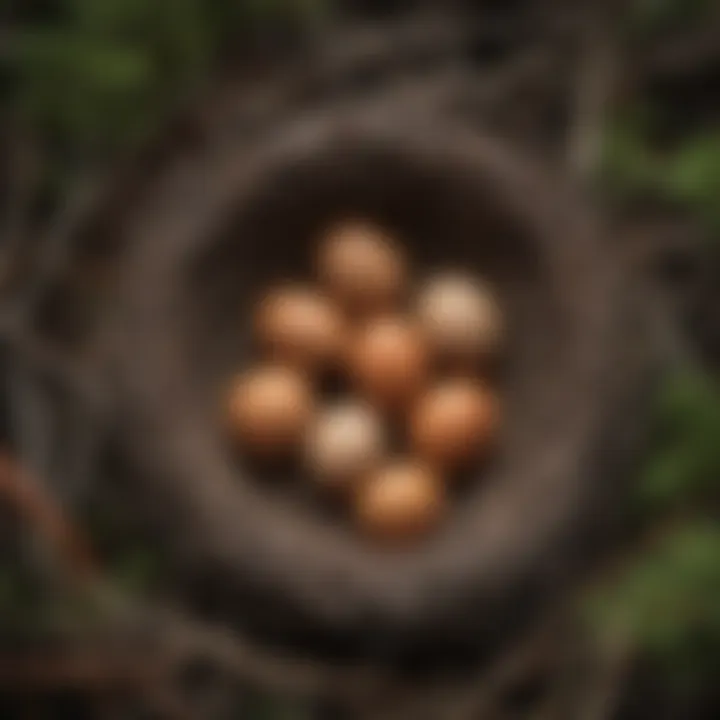
Urban Areas
In urban areas, robins find a smorgasbord of food options from gardens to parklands. These spaces are bursting with fruit-bearing plants and open areas for foraging. One significant aspect of urban living is the absence of many natural predators, which can make city life a safer bet for these birds. Additionally, the presence of humans often leads to plentiful food crumbs—an easy snack!
However, living in cities comes with its share of downsides. Skyscrapers and traffic can pose threats. The noise from bustling streets might also affect their communication and flight patterns. Still, urban areas are a popular preference for robins due to the accessible resources and generally favorable conditions.
The adaptability of American Robins lets them thrive in environments often dominated by human activity.
Forested Regions
Forested regions offer another layer of complexity to the robin's lifestyle. Here, they immerse themselves in a lush canopy of trees and undergrowth. This environment provides both shelter and a wide array of food options—berries, insects, and worms. A key characteristic of these regions is the variety of levels within the foliage which offer safety from predators and harsh weather.
Despite these perks, forests can be competitive environments. Food resources may be more limited during lean seasons, and nesting sites are often fiercely contested. Still, robins exhibit a keen ability to find a niche in these habitats, showcasing their adaptability further.
Open Fields
Finally, open fields present a unique haven for robins. These areas are prime for spotting insects and foraging for berries growing wild. The key characteristic of open fields is their expansive visibility, which helps robins stay alert for predators. Plus, the open landscape allows them to showcase their flight capabilities, hopping from patch to patch with ease.
Yet, open fields can pose challenges too. In winter months, these areas may have less cover for sheltering from the elements, making survival trickier. The availability of food can vary widely depending on whether crops are growing or being harvested. Still, during certain seasons, these fields become key feeding grounds for robins.
Nest Building Habits
Next up is how robins go about building their nests. This is an essential part of their life cycle and reveals much about their habitat preferences.
Materials Used
When it comes to materials used for nest building, robins have quite a diverse toolkit. They often use mud, grass, twigs, and even bits of paper or plastic—whatever is handy, really. A notable advantage of such a mix is that it provides insulation and durability, allowing the nest to withstand the elements. This blends perfectly with their need to find a safe locale to raise their young.
However, the use of non-natural materials can sometimes be a double-edged sword. While it may be convenient, it doesn’t contribute to a healthy, biodegradable environment. This is why understanding their nesting habits is crucial; it emphasizes the importance of preserving natural resources in their habitats.
Location Choice
The location choice for nesting is just as critical. Robins are known to favor low shrubs, trees, and even man-made structures like porches. This diversity allows them to adapt based on their surroundings. The ability to opt for less conventional locations, such as under eaves or in hanging planters, demonstrates their remarkable flexibility.
It's essential for robins to choose wisely, as a nesting spot protects them from predators and harsh weather. However, the proximity to human dwellings might bring about mixed outcomes; while it can offer security from some natural threats, it can also lead to disturbances from human activities.
Understanding the habitat preferences of the American Robin highlights their adaptability and resilience. The information not only sheds light on their daily lives but also helps inform conservation efforts to ensure they continue to flourish in a changing world.
Seasonal Activities
Seasonal activities of the American Robin delve into the bird's behavior during different times of the year, which is essential not just for survival, but also for maintaining ecological balance. By understanding these seasonal patterns, readers can better appreciate the resilience and adaptability of this fascinating species. These activities are more than mere habits; they carry significance that influences the robin's lifecycle and the ecosystem as a whole.
Migration Patterns
Spring Migration
Spring migration stands as a seasonal hallmark for the American Robin. As the days grow longer and the weather warms, robins venture north from their winter habitats, a journey that can be daunting yet crucial for their reproductive success. This migration is characterized by a flight towards regions filled with abundant food sources, namely berries and insects, which help fuel their energy after a long period of dormancy. Plus, settling in areas dense with vegetation offers protection during breeding.
A notable feature of spring migration is the way robins utilize both instinct and environmental cues. The robins have an internal clock that keeps track of time, triggering their departure when it feels just right. Also, they follow geographic landmarks and the Earth's magnetic fields, showcasing an amazing navigation skill that many admire.
The benefits of this migration are apparent. Not only do they arrive in a more hospitable environment, but they contribute to local ecosystems by pollinating and dispersing seeds, giving new life to the areas they occupy.
On the downside, this journey can be perilous. Robins must avoid predators, harsh weather, and exhaustion. Their survival depends on their ability to adapt quickly, making spring migration both a grand adventure and a test of resilience.
Fall Migration
Unlike spring, the fall migration is driven by instinctual preparation for winter—an awareness that suggests a keen survival strategy. In the fall, robins make their way to warmer climates, often traveling shorter distances compared to their spring trek. The focus shifts from breeding to finding abundant food sources, especially as frosty temperatures become a regular fixture.
One distinctive feature of fall migration is the way robins gather in large flocks. This social behavior helps them keep watch for predators, ensuring a higher chance of survival. Traveling as a group also allows exchange of information about safe routes and feeding grounds.
The advantages in heading south are twofold: robins are able to survive the winter more effectively and avoid stiff competition for resources. However, there are challenges, too. Some may face a lack of food during early fall, requiring them to adapt their diets. Plus, not all robins migrate, with some choosing to stay where food sources are still available, adding to the complexity of their behavior.
Breeding Season Behavior
Mating Rituals
When it comes to mating rituals, robins are not shy about demonstrating their intent. These displays are often a vivid showcase of courtship, where males sing robustly to attract a mate. Their soft, melodious tunes resonate throughout neighborhoods, signaling their readiness for breeding. The mating season showcases not only vocal talents but also physical prowess—robins will often engage in flapping displays or circling flights to show off and establish dominance.
The key characteristic of these rituals revolves around establishing territory. By marking their space, males attract females, showcasing the safest areas for nesting. This tactic continues to be a popular focus in understanding robin behaviors.
While these displays have their advantages, there can be drawbacks as well. Males may experience intense competition, which can lead to conflicts. Thus, it’s essential for them to carefully navigate the nuances of both aggression and attraction.
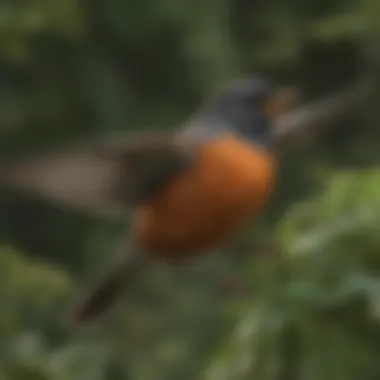

Raising Young
Raising young robins introduces a different layer to the seasonal cycle, carrying significant weight in ensuring the lineage's survival. Female robins play an instrumental role in this process, taking delicate care in constructing nests, often composed of mud, grass, and twigs. This attention to detail speaks volumes about the nurturing instincts inherent in these birds.
An intriguing feature observed during this time is the rapid growth of the chicks. Once hatched, young robins are surprisingly demanding, requiring food consistently. Adult robins engage in frequent foraging to keep up with the ravenous appetites of their fledglings.
The benefit of this familial setup is clear—by investing in their young, robins ensure the continuation of their kind. Parental care during the early stages significantly increases the young's chance of survival. However, this responsibility can also weigh heavy on the adults, who must balance the energy expended in feeding with the need to stay vigilant against predators.
Learning about seasonal activities helps everyone from kids to adults understand the intricate connections within nature. This kind of knowledge fosters an appreciation for wildlife, guiding observers to reflect on their role in supporting ecosystems.
Cultural Significance
The American Robin is more than just a chirpy presence in backyards; it's a symbol stitched into the fabric of culture, especially in North America. Its arrival heralds the spring, making it a harbinger of rebirth and renewal. This connection to the season of growth resonates deeply with people of all ages. Children often associate robins with warmer weather, adventure, and outdoor exploration. Through literature and folklore, this bird has cemented its place in the hearts of many.
Symbolism in Literature and Art
The American Robin has found itself flitting across the pages of poems, stories, and paintings through the years. Writers and artists often draw upon its vivid colors and cheerful song to evoke feelings of happiness and hope. One of the most famous examples can be found in children’s literature, where robins are frequently depicted as wise and friendly characters, often helping others in their little adventures.
"The robin sings the springtime song, reminding us that life is often full of surprises."
In art, its image can vary from a simple, playful depiction to more complex interpretations that explore themes of nature and change. Many paintings capture the robin in mid-flight or perched on a branch, symbolizing freedom and the spirit of wildness.
Moreover, robins play a vital role in songs and nursery rhymes. Take the classic lines that speak of the joys of spring; there's a good chance a robin makes an appearance, serving as a reminder to children of the beauty of nature surrounding them.
Importance in Cultural Narratives
The American Robin’s influence extends to cultural narratives where it represents more than just a bird. It embodies the essence of transition—from winter’s chill to summer's warmth. This transition is crucial for many communities, marking a time for planting gardens or starting new adventures outside.
The robin teaches valuable lessons as well. For instance, the way these birds nurture their young aligns beautifully with themes of love and care, essential messages conveyed through educational stories. It emphasizes family and the support structures created within communities, mirroring behaviors that are vital to human interactions.
In essence, the American Robin is a cultural touchstone. It inspires stories, enriches art, and ignites imaginations. The beauty of this bird lies not only in its physical presence but also in how it resonates within the hearts of those who admire it.
Role in the Ecosystem
The American Robin occupies a unique position in the ecosystem, contributing significantly to both flora and fauna around it. As a common sight in gardens and parks, this bird plays a vital part in maintaining the balance of its environment. Understanding its role helps young readers appreciate how interconnected wildlife can be.
Pollination and Seed Dispersal
The American Robin is not typically known for being a pollinator like bees or butterflies. However, it does help in the process of seed dispersal, which is crucial for plant reproduction and the health of ecosystems. A robin's diet includes fruits, berries, and seeds. With every berry it eats, the robin contributes to the growth of plants.
Here are some key points regarding how robins aid in seed dispersal:
- Seed Transportation: When robins consume berries, they often travel several yards away from where they found their meal. Once they digest the berry, they excrete the seeds in their droppings. This process allows seeds to germinate in new locations, which fosters biodiversity.
- Nutrient Distribution: The droppings of the American Robin are not just carriers of seeds; they also provide nutrients to the soil, making it richer and more suitable for plant growth. An aspect that could be overlooked is how important these nutrients are for the surrounding vegetation to thrive.
- Encouraging Diversity: By spreading seeds from various plants, robins promote a diverse ecosystem. Plants that thrive in different environments in turn provide habitats and food sources for many other animals.
"Nature knows best, and every little creature contributes to its grand design. The American Robin is no exception."
In terms of conservation, protecting the habitats of the American Robin can indirectly benefit the plant species it interacts with. This shows how essential every creature, no matter how small, can be to the health of the environment. By teaching children about these relationships, we cultivate an understanding and respect for nature that can influence their behavior towards wildlife in their local areas.
Conservation Status
Understanding the conservation status of the American Robin is crucial, especially as it helps us recognize how human activities impact this charming bird. Though these robins are common to see flitting from branch to branch, their populations are affected by various threats. Over the years, the American Robin has showcased remarkable adaptability, but they are not immune to the challenges posed by a changing environment.
One key aspect of assessing the conservation status is identifying and addressing the threats to their population. Recognizing these threats is an essential step towards ensuring the survival of the American Robin.
Threats to Population
The preservation of the American Robin hinges on understanding specific dangers it faces in the wild. Here are some of the significant threats to consider:
- Habitat Loss: Urbanization leads to the destruction of forests and open spaces, which decreases the availability of suitable nesting sites and food sources.
- Pesticides and Chemicals: The use of chemical pesticides in agriculture can have devastating effects on robins by reducing their food supply which includes insects and berries. This phenomenon can harm not only their feeding habits, but also their reproductive success.
- Climate Change: Changing weather patterns can disrupt migration and nesting seasons, creating a mismatch in food availability. This aspect highlights the delicate balance each species maintains with its environment.
"The American Robin may be a common sight, but their wellbeing is tied closely to the health of their environment."
- Predation: Natural predators, such as cats and raccoons, pose a threat especially to young chicks. Understanding this aspect is essential for protecting their nests and ensuring survival of the young.
- Disease: Viral infections and parasites can spread through populations, weakening their numbers. Increased exposure to pathogens has been noted due to changes in habitat.
These points all contribute to a broader understanding of the challenges facing the American Robin. By engaging with these threats, we can foster deeper awareness and promote efforts to protect this beloved bird. Conservation isn't just a buzzword; it's a call to action that invites everyone to take part in safeguarding our feathered friends.
Culmination
Reflecting on the American Robin’s various characteristics offers reveals its importance not just as a bird, but as an integral piece of the ecosystem. Through exploring its physical traits, behavioral patterns, and the environmental roles it fulfills, we gain a deeper appreciation for this species. Understanding these aspects can further impact our connection to nature, encouraging us to become stewards of our environment.
The American Robin serves as a symbol of seasonal changes, often signaling the arrival of spring, which can be especially engaging for young audiences. For children aged 5-12, recognizing this connection can spark curiosity about wildlife and encourage them to learn more about birds in their backyard.
Some critical points highlighted in this article include:
- The robust size and distinctive coloring of the American Robin make it easily recognizable.
- Its feeding habits showcase adaptability, feeding on fruits and insects alike.
- As a migratory bird, the robin undergoes significant transformations during its seasonal journeys, teaching us about the cycles of nature.
- Understanding its role in the ecosystem, including seed dispersal, shows how interconnected all living things are.
"By observing the habits of the American Robin, we can better understand our surroundings and the incredible web of life that exists."
These elements not only paint a richer picture of the American Robin but also lay the groundwork for appreciating wildlife in general. It’s vital to instill in children and educators alike a sense of respect for animals around them. Encouraging further education and engagement in nature can have lasting effects on how we view our environment and the creatures that inhabit it.







